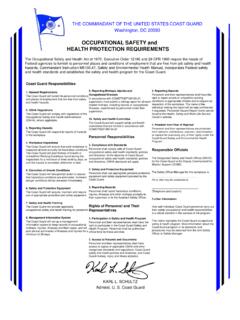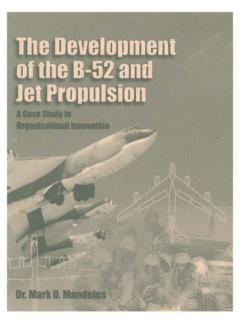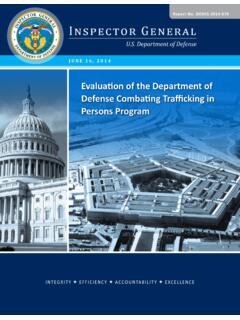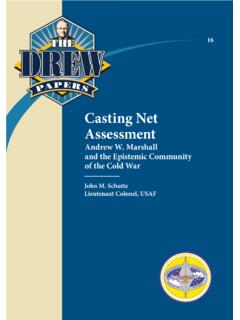Transcription of Next Generation Bioweapons: Genetic Engineering and BW
1 next Generation Bioweapons: Genetic Engineering and BW14US Air Force Counterproliferation CenterFuture Warfare SeriesNo. 14 Michael J. Ainscough253 CHAPTER 9 next Generation Bioweapons: Genetic Engineering and BW Michael J. Ainscough Introduction The history of warfare and the history of disease are unquestionably interwoven. Throughout the history of warfare, disease and non-battle injury have accounted for more deaths and loss of combat capability than from actual battle in war itself. The most striking example is the great influenza pandemic during World War I that killed 20 million people or more worldwide in Although this was a naturally occurring event, what if a country could create a biological agent that could yield the same catastrophic loss of life on the enemy? That, in essence, is the potential effect of applying Genetic engineering2 for biological warfare (BW) or bioterrorism (BT).
2 Today, we face not only natural diseases (including emerging infectious diseases), but also threats of BW or BT, possibly with genetically engineered agents, that may resist known therapies. In simple terms, Genetic Engineering is the process of human intervention to transfer functional genes (DNA) between two biological organisms. In the BW/BT context, it is the manipulation of genes to create new pathogenic characteristics (increased survivability, infectivity, virulence, drug resistance, etc). Organisms with altered characteristics are the next Generation biological weapons. In this century, it is widely predicted that advances in biology and biotechnology will revolutionize society and life as we know it. At the same time, the black biology of biotechnology which can be used to next Generation Bioweapons: Genetic Engineering and BW 254 create biological weapons, will be one of the gravest threats we will face.
3 In this era when cloning and designer genes are topics of the evening news, much has been written about biowarfare and bioterrorism resulting from genetically altered microbes, and it is often difficult to discern fact from fiction. This chapter has two purposes. The first part consolidates accounts of Genetic Engineering from sources close to the former Soviet Union s BW program. The remainder of the paper discusses near-term future capabilities of Genetic Engineering and biological warfare from an American perspective. The next Generation of biological weapons made possible through Genetic Engineering will be asymmetric weapons par excellence. The Former Soviet Union s Biological Warfare Program Biopreparat Despite signing the 1972 Biological and Toxin Weapons Convention (BWC), it is now certain that the former Soviet Union (FSU) continued a clandestine and illegal offensive biological weapons program until at least the early 1990s.
4 Biopreparat (a huge military program with civilian cover) was organized to develop and weaponize biological agents for It employed approximately half of the Soviet Union s 60,000 workers in more than 18 BW facilities, and in the 1980s had an annual budget equivalent to tens of millions of Unlike the American offensive BW program (1942-69) that worked primarily with organisms that were not contagious in humans ( , anthrax and tularemia), the Soviet BW research and development program also sought out the most contagious and lethal bacteria ( , plague) and viruses ( , smallpox) known to Because Biopreparat and other Soviet BW research facilities operated under the highest security classification of Special Importance (higher than Top Secret), the intelligence community did not even know it existed until 1989 when a top ranking scientist from the BW program defected to the United From his extensive debrief, and subsequent collaboration by two other defectors from the program, we Ainscough 255 now know detailed information on the Genetic Engineering successes and other advances in Russian microbiology.
5 Obviously much of the data remains classified, but the three defectors accounts have been documented to some extent in various unclassified books and articles. This paper discusses their open-source accounts. Pasechnik In October 1989, Dr. Vladimir Pasechnik, the first primary source from inside the Soviet program, defected to A top Soviet microbiologist and Director of the Institute for Ultra Pure Biological Preparations in Biopreparat, he described the extensive organization of biological research and production facilities in the program. In addition to confirming that the Soviet Union had an offensive BW program in violation of the 1972 BWC, he disclosed that the Soviets had an extensive Genetic Engineering program aimed at developing new kinds of biological weapons against which the West would be defenseless. 8 His institute s top priority was to increase the lethality of plague and tularemia, and at the same time make them more resistant to antibiotics and temperature extremes.
6 By introducing specially engineered plasmids9 into successive generations of tularemia cultures, the strain became resistant to all known Western antibiotics. The dried, powdery super-plague became the Soviet weapon of choice (20 tons in stock at all times) and was loaded on various munitions. The use of BW had been integrated into Soviet special war plans for a range of tactical operations where they would have been delivered using spray tanks and cluster bombs and strategic operations where intercontinental ballistic missiles (ICBMs) and strategic bombers would have carried plague, anthrax, or Pasechnik also detailed work on perfecting other new strains of bacteria and viruses that would aerosolize well for use in After 30 years of experimentation, Soviet scientists had solved the problems of fragile microbe survival in major atmospheric pressure changes and temperature extremes during missile flight by fitting BW rockets with astronaut cabin-like protective systems.
7 They solved the destruction on explosion problem by selecting the hardiest strains and calculating the required redundant quantity needed based on explosive testing done in Biopreparat and other BW research labs. next Generation Bioweapons: Genetic Engineering and BW 256 In summary, Pasechnik had disclosed that the Soviets (1) had genetically engineered bacteria and viruses, (2) weaponized the microbes in a powder form, (3) loaded them onto various munitions, and (4) integrated BW into their doctrine and had specific plans for use of Temple Fortune In the spring of 1992, a lower-level bench scientist who had worked on plague research in Pasechnik s lab also defected to the United He has remained undercover and is referred to by code-name Temple Fortune. He fully corroborated Pasechnik s previous account, and then updated the British on Soviet BW work in the 30-month interval from Pasechnik s departure to that of Temple Fortune.
8 President Mikhail Gorbachev had ordered the termination of biological offensive programs in 1990, and despite the fact that President Boris Yeltsen had also announced (by televised address to the Russian people and in a personal commitment to President Bush) termination of the program, research on new forms of plague had secretly Temple Fortune stated that, in addition to being even more resistant to multiple antibiotics, the improved super-plague would be non-virulent in its stored form, but could be easily converted into a deadly antibiotic-resistant form when needed for The genes that cause plague virulence are located on a plasmid. What he was describing was a binary biological weapon, where benign bacterial plague cells would be mixed with virulence-enhancing plasmids immediately before loading on a weapon, and the transformation would take place in a small bioreactor on the weapon Alibekov In late 1992, shortly after Temple Fortune s defection, Dr.
9 Kanatjan Alibekov became the third defector from the Russian BW As the Deputy Director (number-two man) of Biopreparat and an infectious disease physician/epidemiologist, he was the highest ranking defector ever from the program. (Dr. Alibekov anglicized his name and now goes by Ken Alibek.) In 1999, Alibek published Biohazard, a first-hand detailed account of his experiences. Alibek disclosed a virtual encyclopedia of Ainscough 257 intimate details on Biopreparat from the top down: personnel and facilities, history of the offensive research, medical and microbiological discoveries, special production methods, weaponization techniques, aerosol testing, Russian BW defensive innovations, prior deceptions and secret plans, and the future direction of the Alibek confided that Soviet biologists in the 1960s and 1970s were already interested in using genetics and gene manipulation to produce BW agents.
10 In 1973, President Leonid Brezhnev established the Enzyme program to modernize the BW program and develop genetically altered Early in his career, Alibek had been in charge of developing Biopreparat s first vaccine-resistant tularemia Later, by 1986, his team had also tripled the potency of the battle strain of anthrax (Strain 836).21 He was the first to weaponize glanders, and supervised the first Soviet tests with the Marburg virus (an Ebola-like virus).22 Alibek disclosed that by 1992 the Russians possessed a grand total of fifty-two different biological agents or combination of agents, including deadly Marburg, Ebola, and smallpox viruses, that could be weaponized. The most infectious and easiest to manufacture and transport microbes were labeled battle strains. 23 The favorite battle strains were anthrax (Strain 836), Pasechnik s super-plague, and a special Russian strain of tularemia (Schu-4).















